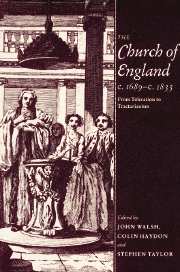1 - Introduction: The Church and Anglicanism in the ‘long’ eighteenth century
John Walsh and Stephen Taylor
Published online by Cambridge University Press: 13 October 2009
Summary
Despite some valuable recent studies, most notably Jonathan Clark's influential English Society 1688–1832 (1985), the history of the eighteenth-century Church of England has long been neglected. In 1860 Mark Pattison wrote that ‘the genuine Anglican omits that period from the history of the Church altogether. In constructing his Catena Patrum he closes his list with Waterland or Brett, and leaps at once to 1833, when the Tracts for the Times commenced – as Charles II dated his reign from his father's death.’ The same holds good for church history in many university and college syllabuses today, in which the eighteenth century is quietly omitted.
Since Victorian times the historiography of the eighteenth-century Church has often had a strongly judgemental slant. High Churchmen who revered the Caroline divines have found it hard to forgive the expulsion of the Nonjurors, ‘the candlestick of the Church’; Evangelicals have censured it for its rejection of the Methodist movement of Wesley and Whitefield. Victorian Churchmen saw it as an era of decline, a period ‘of lethargy instead of activity, of worldliness instead of spirituality, of self-seeking instead of self-denial, of grossness instead of refinement’. This was the case not only with clerical partisans but even with the most accomplished and fair-minded of church historians: the tone of Abbey and Overton's Victorian classic, The English Church in the Eighteenth Century, was gloomy.
- Type
- Chapter
- Information
- The Church of England c.1689–c.1833From Toleration to Tractarianism, pp. 1 - 64Publisher: Cambridge University PressPrint publication year: 1993
- 5
- Cited by



